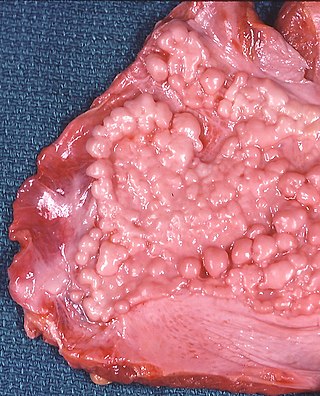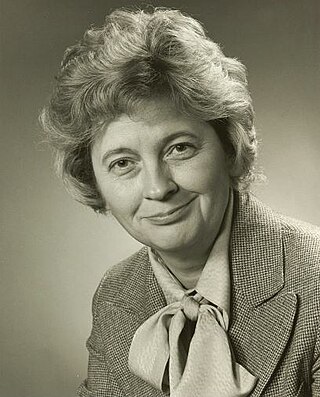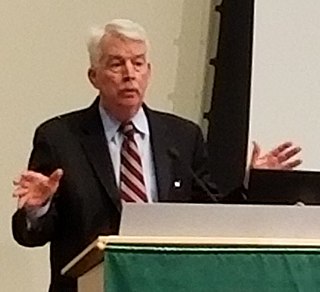Related Research Articles

Asbestosis is long-term inflammation and scarring of the lungs due to asbestos fibers. Symptoms may include shortness of breath, cough, wheezing, and chest tightness. Complications may include lung cancer, mesothelioma, and pulmonary heart disease.

Occupational hygiene is the anticipation, recognition, evaluation, control, and confirmation (ARECC) of protection from risks associated with exposures to hazards in, or arising from, the workplace that may result in injury, illness, impairment, or affect the well-being of workers and members of the community. These hazards or stressors are typically divided into the categories biological, chemical, physical, ergonomic and psychosocial. The risk of a health effect from a given stressor is a function of the hazard multiplied by the exposure to the individual or group. For chemicals, the hazard can be understood by the dose response profile most often based on toxicological studies or models. Occupational hygienists work closely with toxicologists for understanding chemical hazards, physicists for physical hazards, and physicians and microbiologists for biological hazards. Environmental and occupational hygienists are considered experts in exposure science and exposure risk management. Depending on an individual's type of job, a hygienist will apply their exposure science expertise for the protection of workers, consumers and/or communities.

Bernardino Ramazzini was an Italian physician.
The mineral asbestos is subject to a wide range of laws and regulations that relate to its production and use, including mining, manufacturing, use and disposal. Injuries attributed to asbestos have resulted in both workers' compensation claims and injury litigation. Health problems attributed to asbestos include asbestosis, mesothelioma, lung cancer, and diffuse pleural thickening.
An occupational disease or industrial disease is any chronic ailment that occurs as a result of work or occupational activity. It is an aspect of occupational safety and health. An occupational disease is typically identified when it is shown that it is more prevalent in a given body of workers than in the general population, or in other worker populations. The first such disease to be recognised, squamous-cell carcinoma of the scrotum, was identified in chimney sweep boys by Sir Percival Pott in 1775. Occupational hazards that are of a traumatic nature are not considered to be occupational diseases.
The International Commission on Occupational Health (ICOH) is an international non-governmental professional society, founded in Milan during the Expo 1906 as the Permanent Commission on Occupational Health.

Eula Bingham was an American scientist, best known as an Assistant Secretary of Labor for Occupational Safety and Health (OSHA) during the Presidency of Jimmy Carter. During her tenure as the head of OSHA, she eliminated more than 1,000 pedantic regulations and shifted the agency's focus to health and safety risks, establishing strict standards for workers' rights to know about their exposure to hazardous substances.
Occupational and Environmental Medicine (OEM), previously called industrial medicine, is a board certified medical specialty under the American Board of Preventative Medicine that specializes in the prevention and treatment of work-related illnesses and injuries.

Irving J. Selikoff was a medical researcher who in the 1960s established a link between the inhalation of asbestos particles and lung-related ailments. His work is largely responsible for the regulation of asbestos today. He also co-discovered a treatment for tuberculosis.
Health hazards in semiconductor manufacturing occupations are a major issue of occupational hygiene due to the chemical hazards required to produce semiconductors in the semiconductor industry. The manifestations of exposure to health hazards during the production process often occurs at a low level and the effects of the toxins may take decades to surface.

Philip John Landrigan, is an American epidemiologist and pediatrician. He has campaigned against substances in the environment that are harmful to children, such as lead and asbestos. He is also concerned with environmental pesticides.

David Michaels is an American epidemiologist and professor in the Departments of Environmental and Occupational Health and Epidemiology at the Milken Institute School of Public Health of the George Washington University. He held high-level, senate-confirmed public health positions in the administrations of Presidents Barack Obama and Bill Clinton, including a stint from 2009 to 2017 as the administrator of the Occupational Safety and Health Administration.
Paul James Lioy was a United States environmental health scientist born in Passaic, New Jersey, working in the field of exposure science. He was one of the world's leading experts in personal exposure to toxins. He published in the areas of air pollution, airborne and deposited particles, Homeland Security, and Hazardous Wastes. Lioy was a professor and division director at the Department of Environmental and Occupational Health, Rutgers University - School of Public Health. Until 30 June 2015 he was a professor and vice chair of the Department of Environmental and Occupational Medicine, Rutgers University - Robert Wood Johnson Medical School. He was deputy director of government relations and director of exposure science at the Rutgers Environmental and Occupational Health Sciences Institute in Piscataway, New Jersey.
The Collegium Ramazzini is an independent, international academy composed of physicians, scientists, and scholars from 35 countries. Through its members and activities, it seeks to advance occupational and environmental health by bridging scientific knowledge with socio-political centers that have the responsibility to protect public health. The organization is named after physician Bernardino Ramazzini (1633–1714), known as “the father of occupational medicine.”

Occupational safety and health (OSH) or occupational health and safety (OHS) is a multidisciplinary field concerned with the safety, health, and welfare of people at work. OSH is related to the fields of occupational medicine and occupational hygiene and aligns with workplace health promotion initiatives. OSH also protects all the general public who may be affected by the occupational environment.
Stephen M. Levin was the medical director of the Mount Sinai Irving J. Selikoff Center for Occupational and Environmental Medicine, a professor of occupational medicine at the Mount Sinai School of Medicine, and the co-director of the World Trade Center Worker and Volunteer Medical Screening Program. A graduate of Wesleyan University and then New York University School of Medicine, Levin was born and raised in Philadelphia to working-class parents—his father was a carpenter, his mother a hospital worker. He was recognized worldwide as a leader in the field of occupational medicine, particularly due to his work on behalf of 9/11 workers and those injured by asbestos in the town of Libby, Montana.
Occupational epidemiology is a subdiscipline of epidemiology that focuses on investigations of workers and the workplace. Occupational epidemiologic studies examine health outcomes among workers, and their potential association with conditions in the workplace including noise, chemicals, heat, or radiation, or work organization such as schedules.

The Mount Sinai Selikoff Centers for Occupational Health are a set of occupational and environmental health clinics that focus on the prevention, diagnosis, and treatment of workplace injuries and illnesses. Significant injuries and illnesses that are treated at the clinical centers include occupational lung cancers, manganese/silica/lead exposures, and asbestos-related illness, which was the career-long research of Dr. Irving Selikoff, the centers' inaugural director. The Selikoff Centers for Occupational Health's multidisciplinary health care team includes physicians, nurse practitioners, industrial hygienists, ergonomists, social workers, and benefits specialists, who are "leaders in the prevention, diagnosis and treatment of workplace injuries and illnesses," and provide comprehensive patient-centered services in New York City and Lower Hudson Valley. The clinical centers are located within the Icahn School of Medicine at Mount Sinai under the Division of Occupational and Environmental Medicine.

All types of asbestos fibers are known to cause serious health hazards in humans. The most common diseases associated with chronic exposure to asbestos are asbestosis and mesothelioma.
Samsung, a Korean electronics company, began producing semiconductors in 1974 and has grown to become one of the largest semiconductor fabricators in the world. In the decades following Samsung's entrance into semiconductor fabrication, many of its workers developed serious illnesses, including leukemia, lymphoma, and multiple sclerosis (MS). Beginning in 2007, the families of the impacted workers, with the help of a variety of domestic and international organizations, organized and mobilized against Samsung in the form of various protests and legal challenges. This organized opposition lasted for over a decade and largely concluded upon the signing of a binding settlement agreement between Samsung and the relevant opposition leader. Additionally, Samsung issued a public apology and acceptance responsibility for causing an increased risk of serious illness in its semiconductor factories.
References
- ↑ Aspen Daily News, November 17, 2023. "Obituary: Joseph "Joe" LaDou". Accessed: November 28, 2023.
- 1 2 3 Harrison, Bob, et al. (2023, Nov. 16) "The passing of Joe LaDou, MD, UCSF emeritus professor and leader in occupational and environmental medicine." Chair's Corner, UCSF Department of Medicine. Accessed: November 28, 2023.
- ↑ International Journal of Occupational and Environmental Health website. Accessed: August 9, 2015.
- ↑ LaDou, Joseph. 2020. "A World of False Promises: International Labour Organization, World Health Organization, and the Plea of Workers Under Neoliberalism," International Journal of Social Determinants of Health and Health Services, 50(3):314-323. doi : 10.1177/0020731420917912
- 1 2 Miller, Jeff. (1999, January). "Joe LaDou: The Invisible Man," UCSF Magazine.
- ↑ Collegium Ramazzani. (1998, October 24). Certificato Onorem, Joseph LaDou. Available: https://www.collegiumramazzini.org/download/1998_CERTIFICATO_ONOREM_Ladou.pdf. Accessed 8 November, 2023).